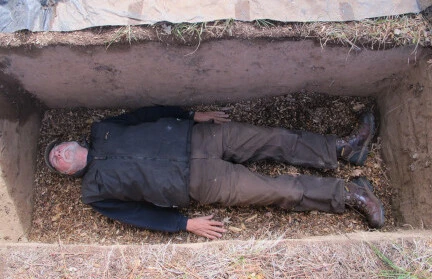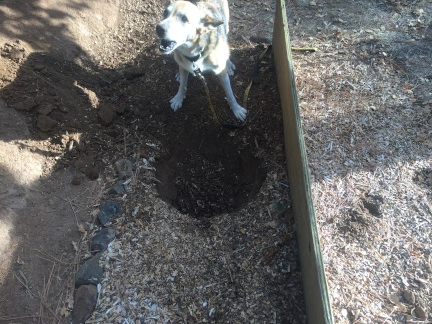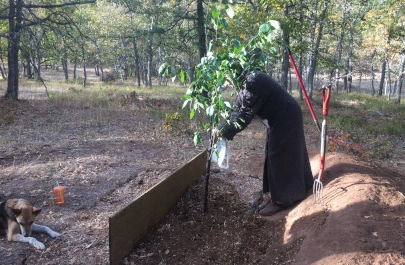Honey Helps

Honey waiting to help
Honey knew the human wasn’t well, but she did all she could to comfort her. Honey would climb onto the bed with Lois and cuddle, and was a wonderful companion during dark days.
Lois was loved and cared for by her husband and daughter, but Honey’s love for Lois wasn’t burdened by the knowledge that the time remaining was drawing to an end.
When Lois passed, her remains were laid to rest in the Herland Forest to await an eventual reunion with her husband and daughter. Their graves were already laid out next to hers.
When the dry months of August and September gave way to the rains of October, the family came to plant a plum tree on Lois’ grave. Honey came too.
When planting a tree, the first step involves digging through the dirt cap that has sealed the grave. That’s important since the goal is to facilitate the ability of the young roots to reach down into the compost. Over the months since the interment, nature has been transforming the remains and the wood chips into the soil that will nourish the tree.
When we bury someone, we hand dig a chamber that’s sized to receive an appropriate balance of remains and wood chips—in effect, the grave functions as an over-grown clay flower pot.

First we lay down a layer of wood chips upon which the remains are laid to rest. Here’s a picture of me laying in a grave that’s ready to receive a person’s remains. There’s a hundred gallons of wood chips below me, and after the decedent is laid to rest, another hundred gallons of wood chips will be added on top.
The next step is to add a dirt cap to seal the grave. When it’s time to plant a tree on the grave, the first task is to dig through the dirt cap. That will enable the new tree to send its roots directly down into the moist compost without having to work its way through the dirt cap.
When the family came to plant the tree, they brought Honey with them. At first Honey seemed confused, but she quickly got the idea that they were there to dig a hole. She understood all about digging holes.
As the hole got deeper, Honey became increasingly energetic in her efforts to remove the soil that was loosened by the shovel. I believe she was picking up Lois’ scent and wanted to find her friend.
After removing the loose dirt, Honey would stand back to allow more dirt to be broken loose. As she watched, she barked encouragement to Lois’ family.
Once a sufficient hole had been dug through the earth cap, Honey could tell that her work as done. She stepped back and lay down to watch as the tree was lowered into the hole.
More compost was added to complete the connection between the root ball and the ground, and then a mulch of wood chips was added to help retain moisture.
 With the work done, it was time to leave the plum tree to rest and settle in for the winter. In the spring, it will “wake up” in its new home and add another bit of beauty to Herland’s permaculture forest.
With the work done, it was time to leave the plum tree to rest and settle in for the winter. In the spring, it will “wake up” in its new home and add another bit of beauty to Herland’s permaculture forest.
